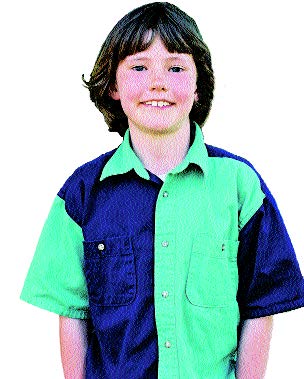Is it possible we are born knowing everything, slowly unlearn it as we become socialized, and then, if we are lucky, begin to relearn it all before we die? Certain people make that hypothesis seem plausible. At least the Born Knowing part. Alexandra Moon was born knowing that she was more than just a girl. She stands in front of her favorite tree, an oversized triangle of a fir, a perfect tomboy totem rising smack from the middle of her front-yard lawn. Her shoulders are broad and her hands are thrust in her khaki pockets. She shifts and smiles and without breaking her grin says she loves this tree, and she especially loves to race her twin sister Isabel to the top of it. “I like to climb the highest,” she says, “but a lot of times Isabel wins.”
Isabel is a girl, according to Alexandra, and she, Alexandra, is “both.” This pretty freckle-face seven-year-old from a quiet suburb in the Bay Area has apparently known from day one what most of us take a long time to figure out: That we humans, despite our most obvious physical attributes, are some parts girl, some parts boy. And, that this is a good thing.
Her room is much like other little girls’ rooms—light blue and carpeted, butterfly art hanging on the walls. But unlike her sister’s side of the room, which is adorned with doe-eyed glass animals, winsome dolls, and a slew of lacy, pillowy items, Alexandra’s white shelves are lined neatly with papier-mache monsters, three-headed dogs, a portrait of “Art Dog” and other creatures recognizable only as mischief-makers. She points out a framed photo in which she is laughing with her sister and their three best friends, and describes what happens when this group plays with dolls. “I just don’t know what to do. So I stand there.” What, and with whom, does she prefer to play? “At first the boys at school were mean to me. They said I was a girl and wouldn’t let me do stuff. Then I just got friends with them and I was their best friend.”
It is the lack of defensiveness with which Alexandra describes her status as both boy and girl that is so exquisite; yet it is mysterious how she has remained so psychically intact through a couple of years of elementary school. It might have something to do with her father’s English public school upbringing. He has a deeper understanding of the wake of early childhood conformity than most, and children dash about the Moon home in a cloud of utter acceptance. It is within this vivarium that Alexandra’s rich little soul has survived, and thrived.
So what sort of penchants does she harbor, this sandy-haired girl with a white eyelet bedspread who also runs around with first-grade thugs building forts and “overflooding” the sandbox to make moats and castles? Clothes with lots of pockets are best. Clothes like the ones her older brother Dylan wears, that zip and button and “look cool” and “don’t feel itchy” as dresses tend to. Potions are excellent. Stories should be about monsters, gnomes, dinosaurs, and dragons with fire breath. When it comes to drawing, it’s all about robots. Oh, and little men with caps and shovels, floating downward toward boulders on which they will, presumably, work. A “cartoon drawer” is what Alexandra wants to be when she grows up. Speaking of growing up, will she wear boys’ clothes or girls’ clothes? Maybe when she’s “half grown-up, half kid” she’ll start to wear dresses.
Alexandra did wear a dress once, recently, to a piano recital. “My parents said I didn’t have to, but if I wanted to try it I could. It felt good while I was doing it, but then I felt like I shouldn’t be doing it so I took it off.”
Imagine this: Alexandra holds tight to the unusual wisdom she carries, and she gets to stay “both.” Envision her, a young woman, statuesque in a long, loose dress, grasping a shovel and floating gently downward toward a boulder, where her coveralls and cap await her.





